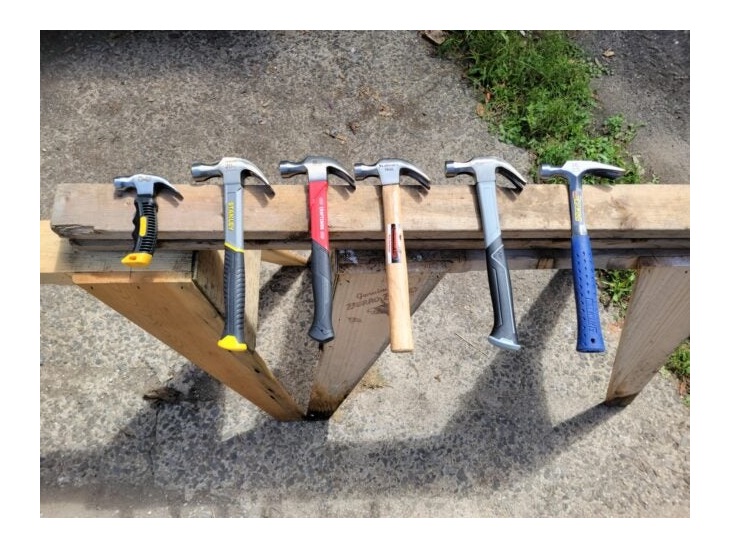Best Hammers in 2023- One of the most common tools used by skilled homeowners to finish a variety of DIY projects is a hammer. The This Old House Reviews team describes the top seven hammers in this review, along with how they fared in our tests. The items mentioned in this article can be purchased from a variety of home improvement stores, neighborhood home centers, and internet merchants like Amazon.
At Linquip, we looked at the comfort, vibration control, craftsmanship, and durability of the hammers. For instance, the Stanley FatMax Anti-Vibe Rip Claw Hammer, with its wide striking face and adaptable 16-ounce weight, is perfect for most do-it-yourself projects or home repairs.
Hammers are produced by a wide range of vendors, Companies, manufacturers, and distributors, and Linquip provides a sizable selection of Hammers for Sale. For all OEM fleets, Linquip’s website provides a comprehensive selection of services. Vendors for Linquip can help you with this. To learn more about how to connect with a variety of service providers who regularly deliver high-quality goods, please Contact Linquip’s Experts.
A toolbox becomes crammed up the more fix-it projects you take on. Whatever the case, a decent hammer is still—and always will be—a handy person’s necessity and has no rivals or substitutes. The instrument that is most frequently used, besides the screwdriver whether it be for hammering in or removing nails, is probably the hammer. Your hammer is probably the tool in your toolbox that gets used the most, second only to a screwdriver.
Knowing what to look for in a good tool pays well. The ideal hammer makes tasks easier and is comfortable in the hand. The incorrect hammer can be painful to the wrist and palm, increase the danger of finger smashes, or even break under prolonged use. See our list of top options and read our buying advice for the best hammer for your needs in the sections below.
What to Consider When Choosing the Best Hammers
The best hammer is secure, doesn’t overexert the user, and aids in a variety of do-it-yourself tasks. Examine the face, claw, length, and weight of the hammer before selecting it for a task. Although professional-level hammers may be tougher, heavier, or longer than standard hammers, most household jobs call for a more straightforward hammer. Selecting a hammer that feels good in the hand and won’t cause excessive fatigue is helpful. Considerations regarding a hammer’s handle material, weight, and claw design should all be made before buying one.
Handle
The majority of hammer handles are made of steel, fiberglass, or wood. Steel handles are the most durable of the three and provide the hammer with more weight to assist drive nails. Nevertheless, depending on the hammer you select, part of the weight may be distributed unevenly, resulting in significant vibrations when the object is struck.
Fiberglass hammers are a less expensive alternative to steel ones and transfer vibrations less than those made of steel. The drawback of fiberglass handles is that they are challenging to replace if they break. The best handles for dampening vibrations are made of wood because they place most of their weight at the hammer’s head for a powerful blow. Some wood handles, however, are weak and prone to shattering.
Wood’s strength can be estimated from its density using its specific gravity. Calculating specific gravity involves dividing the weight of a certain volume of wood by the weight of an equivalent amount of water. Hickory and oak are two often utilized kinds of wood that are dense and robust when considering specific gravity as a measure of strength. Other typical woods used for handles are birch and ash, however, they are less strong due to their lower density.
Type
There are various hammers available, each with a distinct function, however, there may be overlaps. Here are a few of the most typical hammer kinds.
- Claw: The most typical kind of hammer is this one. The head includes a smooth face that won’t damage the wall as you drive the nail home, as well as a claw with a forked, slightly curved tip that is useful for pulling nails out of wood and other materials.
- Framing: Although the claw on these hammers is straight rather than curved, they are quite similar to claw hammers. The face of framing hammers frequently has a faint roughness that aids in keeping nails in place when they are struck.
- Ball Peen: This hammer’s head is spherical and somewhat ball-shaped on one side and flat on the other. No claw is present. Metalworkers typically utilize ball peen hammers.
- Club: These compact, flat-faced instruments, sometimes known as drilling hammers, resemble miniature sledgehammers. Club hammers work well for driving chisels and wedges as well as for mild demolition.
- Rubber Mallet: Mallets, which resemble club hammers in shape but have a rubber head instead of a metal one, aren’t used to drive nails; rather, they’re used to add some force when driving stakes or chisels, building furniture, working with upholstery, or performing other tasks that require more force than your hands can muster while still protecting the surface you’re working on.
- Tinner’s: These hammers have a square face and an unforked, sharp claw. They are primarily employed in metalwork, such as sheet metal fabrication and vehicle maintenance.
Face
The majority of hammers have forged steel heads with either a smooth, waffled, or milled face (although titanium is an option on more expensive versions). If you miss your swing, a smooth face is less likely to cause damage. Although a rough face can “grip” the nail more effectively, it will damage a finished surface, hence these sorts of hammers are best used for framing applications. The best hammer for the majority of DIYers has a smooth face; individuals who perform significant carpentry or building work will likely prefer the increased grip of a milled face.
Weight
The power and portability of a hammer are influenced by its weight. Light hammers provide controlled swings but frequently fail to deliver a powerful strike. Although they are harder to handle than their lighter equivalents, heavy hammers can easily drive nails into boards and other materials. It’s crucial to choose a hammer model that you can regularly swing comfortably.
Claw Style
There are several different types of hammers, such as drywall, roofing, ball peen, and masonry. For our tests, we chose claw-style hammers due to their widespread use, simplicity, and convenience. The use of claw-style hammers is common in tasks like nail-pulling and woodworking.
There are primarily two designs for claw hammers: curved and straight. The rounded claw of curved hammers increases leverage when pulling nails, and they are available in a range of weights to meet the power requirements of various customers. Hammers with straight, or rip claws have a flatter claw that is useful for demolition tasks such as removing tile, wood, or plastic.
Grip
A firm grip helps the user operate the hammer more effectively, especially if their hands are sweaty. Better control makes it less likely that you’ll break a thumbnail instead of a real nail. Hammers made of steel and fiberglass all have some type of grip, while those with wood handles frequently lack one because they are usually inherently sticky (though some carpenters do roughen the handles with sandpaper).
The grip of most hammers is made of a rubbery synthetic material that cushions the blows while also absorbing shock. Another choice is leather; however, it costs more. Leather is just as dependable as a synthetic material; old-school hammers from decades ago still have their strong, polished leather handles that are well kept from the oils of the tradesperson’s hands.
Cost
The majority of high-quality hammers are under $25. The price of a hammer can vary greatly depending on several things, including the material used for the handle. For instance, the Stiletto Ti-Bone Hammer costs more since it is made of sturdy titanium and has a patented side nail puller.
The weight of a hammer also affects its cost, with heavier hammers typically costing more. For instance, the 20-Ounce Straight Rip Claw Hammer from Estwing is more expensive than the 16-Ounce Rip Claw Hammer from Dewalt.
Length
The potential swing length increases with the length of the hammer, creating more momentum for a heavier hit. To do this, a carpenter may use a longer 18-inch hammer for framing and a smaller 16-inch hammer for finishing. DIYers ought to do the same.
Around 16 inches is a nice handle length for everyday use. Short-handled hammers may appear less scary, but they’re a gimmick and quite hazardous. When using a short-handled hammer to miss a nail, the user runs the risk of hitting the nail with their hand, which can lead to a nasty little injury. Additionally, using one of these hammers requires much more force than using a conventional hammer, increasing the danger of slips and strained muscles. Avoid using these tricks.
Additional Features
Some hammers have special features that make it easier to drive or pull nails. To reduce the danger of harm, certain models, for instance, have a magnetic nail starter that enables users to avoid holding a nail in their free hand. Other hammers have claws that have an enlarged head to provide the user extra leverage for pulling nails.
Best Hammers Reviews
Estwing 16-Ounce Steel Claw Hammer
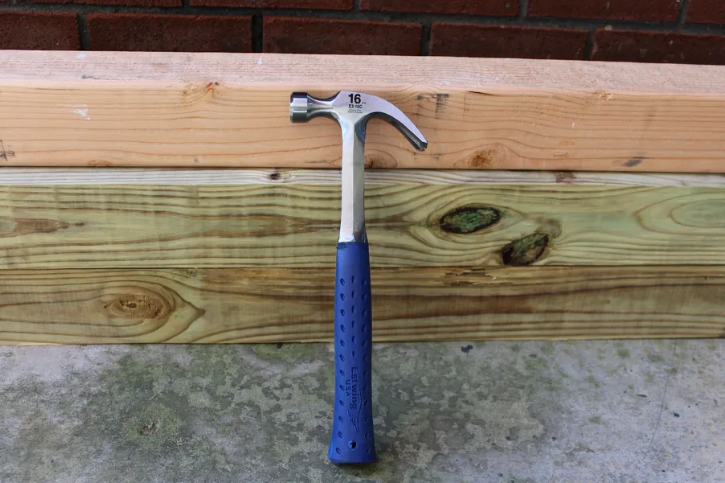
General Descriptions
This 16-Ounce Estwing Hammer has a comfortable grip that is encircled by a sturdy steel frame that effortlessly drives nails and produces a strong swing. Because of its shock-resistant grip, driving nails causes less vibration. The hammer also has a curved claw that effortlessly pulls nails out of wood.
The Estwing Rip Claw 16-Ounce Hammer is capable of handling a variety of tasks, like nailing fence boards into place, hanging pictures, making a doghouse for Rover, and building an addition. It is made of solid forged steel, with a smooth face that won’t rip trim during an accidental impact, and a shock-absorbing grip.
The head and straight handle of the Estwing are made of one piece, making them extremely robust and durable without having a visible weak spot like hammers with wood or fiberglass handles do. Although the handle is made of metal, Estwing has covered it with a plush rubber grip to reduce strain and cushion shock.
Our favorite hammer in the bunch was the Estwing and using it was a real pleasure. It is extremely durable, well-balanced, and shock-absorbing. It drove nails easily and pulled them out just as easily. The sole drawback is that rip claws are tough to use in confined spaces like cupboards and stud bays because they protrude further than curved claws.
The hammer received many favorable reviews that emphasized its strength and fine construction. Some users praised the tool for being accurate and simple to use as well. Customers who received scuffed products or who had trouble removing the attached stickers were among those who complained about how the product was delivered.
- Steel handle
- 16 ounces
- Made in the United States
Stanley 16-Ounce FatMax Xtreme AntiVibe Rip Claw Nailing Hammer
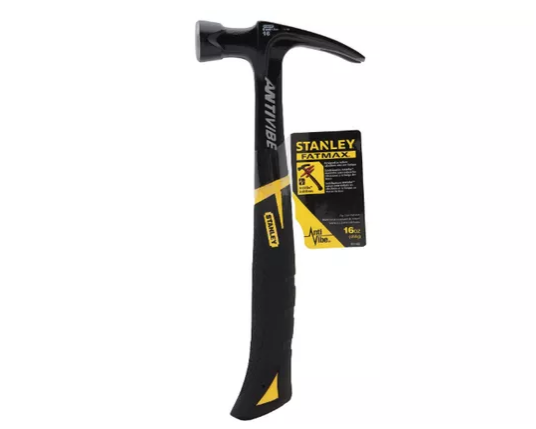
General Descriptions
The FatMax Anti-Vibe Rip Claw Nailing Hammer (51-163) from Stanley, a well-known brand in the tool industry, tops our list of the best hammers to buy. This hammer offers more in terms of design and construction than most others. With its 16-ounce all-steel structure, it can quickly drive nails into tough and dense woods, but it does it in a way that is designed to safeguard the user. Note that hammer weights only refer to the weight of the steelhead, not the complete instrument including the handle.
Over time, hammering can cause a variety of hand and wrist issues, including carpal tunnel syndrome1. Each impact’s vibrations might put a strain on the tendons and bones holding everything together. This hammer reduces risks if you plan to use one frequently by taking the majority of the blow from each strike. The grip is also made to lessen the torque that your wrists and elbows experience as you swing.
Not only that, but this hammer also has a strikeface that is much larger than most other hammers of comparable size. As a result, you are far less likely to swing and miss, strike your thumb instead of the nail, or inadvertently harm the wall with a careless blow. Additionally, it is a tool that should provide you with many years of trustworthy use because it is fashioned from a single length of forged steel.
CRAFTSMAN Hammer, Fiberglass, 16 oz.
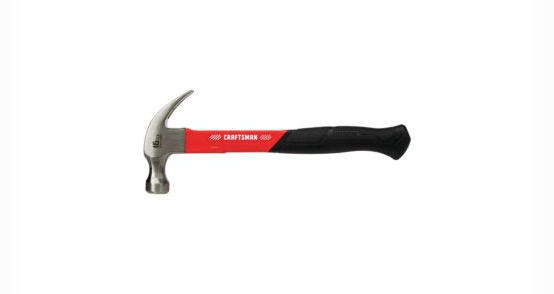
General Descriptions
Check out Craftsman’s 16-ounce hammer if you need a reliable tool that will drive a few nails without driving up your costs. For comfort and durability, this hammer has a rubber over-molded grip, a fiberglass handle, and a forged steel head.
The Craftsman completed each duty test effectively, including driving and removing nails. It also has good shock absorption, and the crimson color makes it difficult to lose on a construction site. During testing, we only discovered one issue: the hatchet-style handle has an excessive curvature that flares out at the knob. Although some people might enjoy it, it made the grip feel smaller and is not essential for a 16-ounce hammer.
- Weight: 16 ounces
- Claw: Curved
- Material: Forged steel, fiberglass handle with textured rubber grip
TEKTON Double-Faced Soft Mallet, 35 mm
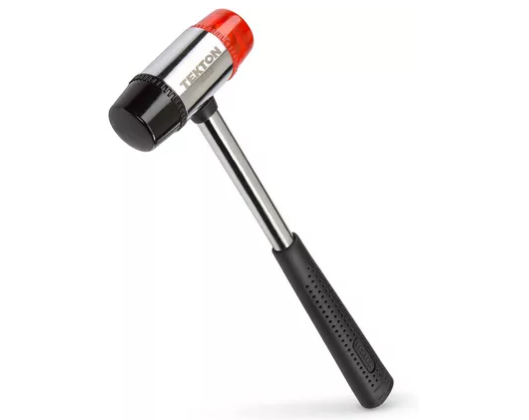
General Descriptions
For some undertakings, the hardest hammer isn’t always the best. The Tekton Double-Faced Soft Mallet (30812) can do the trick if you’re searching for a multipurpose hammer to use for more delicate jobs. The two soft faces, one of which is made of red plastic and the other of which is made of black rubber, are better for hitting objects you don’t want to damage when you strike them repeatedly. This is ideal for securing delicate finishes or finished surfaces while you hammer.
If you require a tool that you can comfortably carry and use for extended hours, the hammer’s body is designed to keep the entire apparatus lightweight. Because the shaft and handle are made of tubular steel, the tool is lighter overall. The hammer will remain firmly in your hands while you swing and strike thanks to the comfortable rubber grip.
- Type: Mallet
- Weight: 11.4-ounce head
- Handle Material: Steel
Stalwart 75-HT3000 16 oz Natural Hardwood Claw
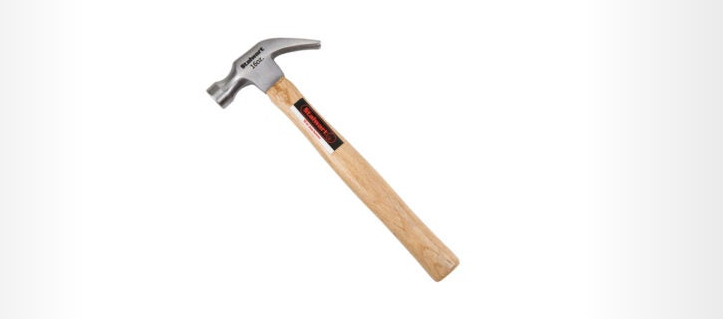
General Descriptions
This hammer from Stalwart should be taken into account by everyone building their first tool set. The handle of this hammer is made of hardwood for a classic method of stress absorption (which it does well). Additionally, it has curled claws for working in small spaces.
The wooden handle is epoxied to the head, so, if necessary, it may be taken off and replaced. However, this is not the simplest option for re-handling. Epoxy does a decent job of holding the two pieces together even though it isn’t as strong as wedging the handle in place.
We were astonished by The Stalwart. It turns out to be a high-quality hammer, contrary to what we had anticipated. When driving nails, the straight handle took all the impact, and the claws did a good job of pulling those nails out. The epoxied handle, which will make handle swaps challenging, is our biggest worry.
- Weight: 16 ounces
- Claw: Curved
- Material: Forged steel head, wood handle
IIT 32380 12-Ounce Stubby Hammer
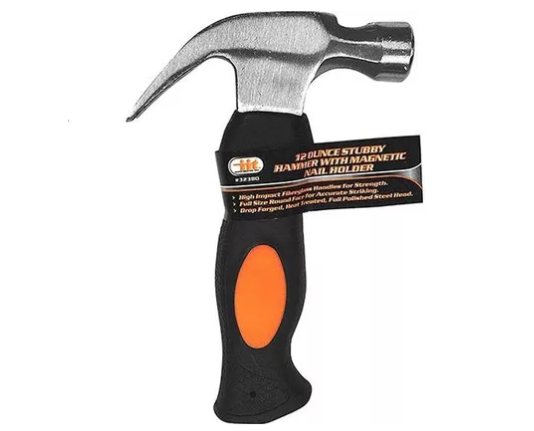
General Descriptions
For light-duty work where you will find yourself hammering for hours on end, choose the IIT 12-Ounce Stubby Hammer (32380). This tool is perfect for working in confined spaces, performing around-the-house repairs, and performing basic carpentry chores because of its stubby size and lightweight, ergonomic handle, which is covered in a soft rubber comfort grip that will work for both right- and left-handed people.
The Stubby is a perfect weight; at 12 ounces, it is neither too heavy nor too light. The weight is practical for when you need a little extra force in your swing, and the steel head is durable enough to withstand repeated usage for lengthy jobs. Its length of 8 inches makes it the ideal size to keep on your tool belt while not in use.
- Type: Claw
- Weight: 12-ounce head
- Handle Material: Fiberglass
Olympia Tools 8-Ounce Wood Claw Hammer
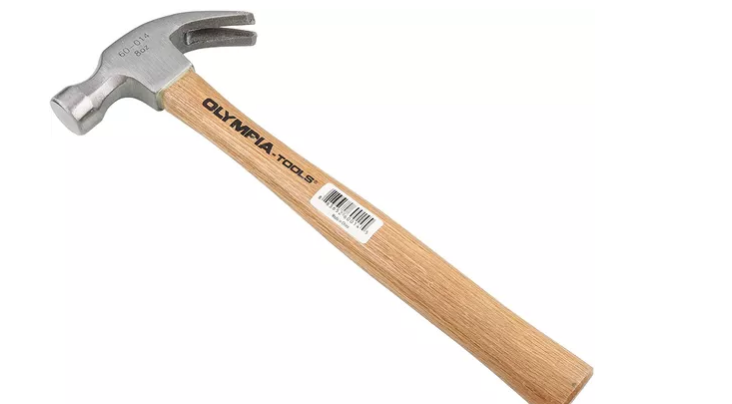
General Descriptions
There is no need for a heavy tool designed for more demanding jobs if the only use your hammer ever sees is driving nails into the wall to hang pictures. Instead, using a lightweight hammer, like the Olympia Tools 8-Ounce Claw Wood Hammer, does the work just as well while putting less strain on your hands, wrists, and walls should you misjudge your swing.
The hammer has a sturdy, solid wood handle that not only looks excellent but also helps to lessen the impact of strikes. The tool’s business end is made of drop-forged alloyed steel, and the end opposite the face has a curved claw for prying nails out of walls or other surfaces.
The hammer won’t take up much space in your toolbox and won’t add much weight to you because it weighs less than a pound overall and is only 11.5 inches long.
- Type: Curve claw
- Weight: 8-ounce head
- Handle Material: Wood
IRWIN Fiberglass General Purpose Claw Hammer, 16 oz
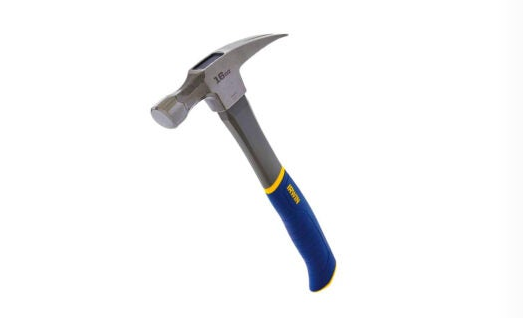
General Descriptions
This fiberglass hammer from Irwin should be seriously considered by anyone looking for a hammer from a reputable brand. This type has a 16-ounce, all-forged steel height, fiberglass handles, and rubber over-molds for stress absorption.
This hammer lived up to Irwin’s reputation for producing smaller, DIY-oriented tools during testing. During the test, the rubber grip on this model was one of the most pleasant. Additionally, the hatchet-style handle curves somewhat but not enough to be uncomfortable. Remember that this hammer includes rip claws, which might be challenging to use in confined spaces.
- Weight: 16 ounces
- Claw: Rip
- Material: Forged steel head, fiberglass handle, rubber grip
FAQs about Best Hammers
Even if the list of the best hammers may have struck the mark, there may still be some unresolved issues. As a collection of some of the most often asked questions concerning hammers, this section will attempt to clarify them. Check the list below for answers to any of your most nagging issues.
1. What Is the Best Brand of Hammer?
Despite the weirdly particular hammer preferences of carpenters and other professionals, Estwing is one of the most popular and widely used hammer brands. The Rockford, Illinois-based business has been producing hand tools for almost a century.
2. How Do You Use a Hammer?
A hammer is relatively simple to use. Holding the handle firmly in one hand, immediately look for any damage, such as rust or a loose hammer head. If the hammer appears secure, set a nail as far from the intended point of impact as feasible using your other hand. Then, if the hammer appears secure, bring the head of the hammer down onto the nail head to drive the nail into the wood.
Additionally, the back of the hammer’s head has a pin or claw that can be used to remove nails. Simply insert the nail’s head into the space between the claw’s two sides and then strike the hammer’s face to drive the nail out of the wood.
Remember that this is only the most fundamental application of utilizing a hammer; there are many other uses as well.
3. Where Should You Hold a Hammer?
Hold your hammer close to the end of its handle to improve leverage and strength to produce as much power as feasible. Keep in mind that holding the hammer too close to the nail’s head will reduce your force and require more strikes to drive the nail.
4. Are Heavier Hammers Better?
Hammers that weigh more are not always better. A 20-ounce hammer swung by someone lacking the same level of proficiency is significantly inferior to a 16-ounce hammer in the hands of a skilled user.
5. How Do You Nail Baseboards with a Hammer?
Baseboards should ideally be secured with a nail gun, but if that’s not an option, a hammer will do the trick. For this purpose, there are specialized hammers called trim and finish hammers.
Hit the nail head with the hammer after aligning it with the stud. When the nail head is flush with the baseboard’s surface, keep driving the nail through the baseboard and into the wall stud. If the nail is protruding, it looks awful, makes it challenging to fill and paint, and may even provide a safety risk to passersby.
6. What Type of Steel Is Used for Hammers?
The majority of hammers are made of simple carbon steel, which is a compound of iron and carbon. This metal is sturdy and resistant to shock, which makes it perfect for hammers and other equipment.
7. What Hammer Weight Is the Best?
The ideal all-purpose hammer weight is typically 16 ounces. It can perform some light work and some framing. Hammers as light as 10 or 12 ounces will suffice, nevertheless, for light-duty tasks. Framing hatchets and heavy-duty framing hammers each weigh close to 30 ounces.
8. What Is a Claw Hammer?
A standard hammer is formally referred to as a “claw hammer.” This design has a strong striking visage in front and a curled claw to assist pull out nails on the back of the head. The most popular hammer among do-it-yourselfers is the claw hammer.
Conclusion
At Linquip, we thoroughly investigate the items we recommend in each review, spending hours looking over the top models. A product must, among other things, have a strong track record of sales, receive consistently excellent customer feedback, and have special features to make our list of top picks. We perform additional research and occasionally in-person testing to make sure the products fit our criteria after reducing our list of suggestions. After we’ve finished our research, we write a thorough, user-friendly article with our suggested items and other details to assist homeowners like you in making the best choice.
Send a message to our reviews team if you have any comments or inquiries regarding this article or contact Linquip’s Experts.
Download Best Hammers PDF
Buy Equipment or Ask for a Service
By using Linquip RFQ Service, you can expect to receive quotations from various suppliers across multiple industries and regions.
Click Here to Request a Quotation From Suppliers and Service Providers
Read More In Linquip
- 8 Best Rust Converter (Ultimate Guide)
- The 10 Best Glues for Metal + Tips for Choosing
- 6 Types of Hammer Drills with Advantages
- The 10 Best Fertilizer Spreader
- 10 Best Steel Toe Boots for Women (Clear Guide)
- Top Fastener Suppliers & Manufacturing
- The 8 Best Pliers + Buying Guide
- The 8 Best Pressure Washers
- The 10 Best Hammers
- The 10 Best Mini/Benchtop Milling Machine
- 8 Best Soldering Iron for Electronics & The Like + Buying Guide
- The 7 Best Portable Band Saws + Tips for Choosing
- The 10 Best Electric Space Heater + Buying Guide
- The 8 Best Engine Hoists & Accessories + Buying Guide
- Top 10 Irrigation Equipment Suppliers
- Top 10 Railroad Equipment Suppliers in USA & Worldwide
- The 10 Best Steel Toe Boots for Women
- Top Brick Manufacturers in USA & Globally
- Top Water Filter Supplier & Companies
- Top Foam Rubber Suppliers in USA & Worldwide
- Top Crushed Stone Suppliers in USA
- The 4 Best Ceramic Coatings
- 8 Types of O-Ring + Applications (Clear Guide)
- The 9 Best Commercial Patio Heaters+ Buying Guide
- The 10 Best Drywall Anchors + Buying Guide
- The 10 Best Box Cutter/Utility Knife Options
- 11 Types of Striking Tools with Primary Use

